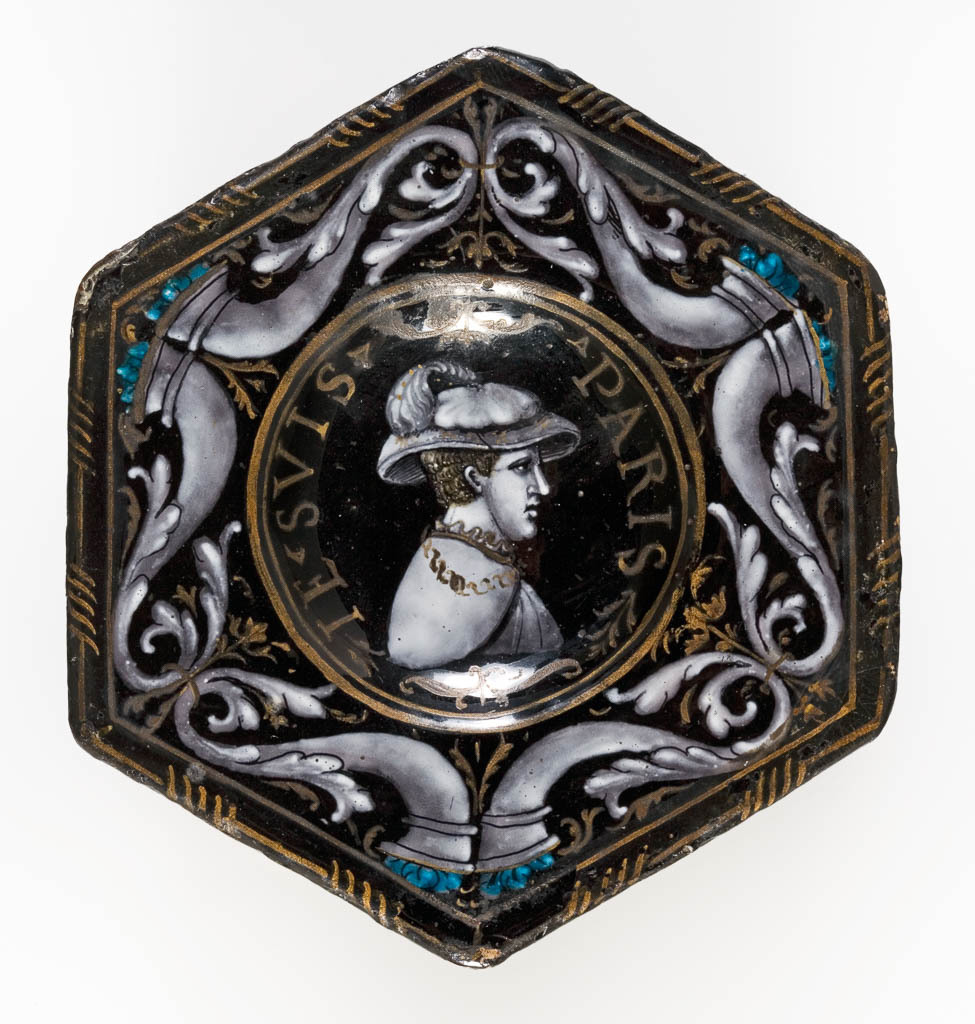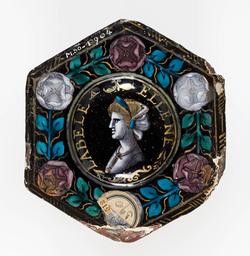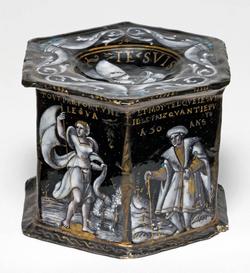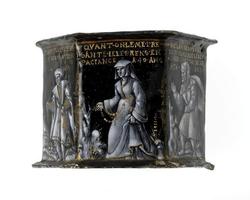Current Location: In storage
Titles
Hexagonal Salt
Maker(s)
Maker:
Nouailher, Colin
(Probably)
Entities
Categories
Description
Copper enamelled in grisaille and in turquoise-green, turquoise and mauve on a black ground and gilded
Hexagonal with straight sides, projecting upper and lower edges, and a concave central depression in the top and base. Copper, enamelled en grisaille on a black ground, and gilded; the top also enamelled in turquoise-green, and the base in turquoise, and pale mauve. The salt pan is decorated with a bust of a man in profile to right wearing a hat with a feather in it, and is inscribed "IE SVIS PARIS" (I am Paris) in gold surrounded by two gold circles. On the flat surround there are three pairs of cornucopia with foliated terminals, containing turquoise fruits. Round the outer edge is a gold line broken at regular intervals by five oblique strokes. In the depression in the base is a head of a woman in profile to left, wearing a turquoise frontlet, a snood, and a turquoise oval cabochon over her ear. The black ground is dotted with gold, and inscribed "LABELLE ELLENE" (Beautiful Helen) in gold within a gold circle. On the flat area there are three white roses and three pale mauve roses linked by stems bearing either two pairs of turquoise or two pairs of green leaves, and pairs of gold tendrils. Round the outer edge is a gold line broken at regular intervals by five oblique strokes. The sides are decorated with six figures flanked by rocks and small gold plants, each with a gold inscription above. From right to left:
Fortune stepping to the right, holding the staff of a billowing pennant in her right hand, and its tail in her left; inscribed "TOVT. FORTVNE/LE VA" with an orb between the LE and VA.
A jester steps to the left raising his right hand, and holding a jester's staff over his shoulder in his left; inscribed "IL SEMBLE AVVILART.ABVZ.QVE.LES. IEVLX/DAY MER SOYENT PERDVZ" (It seems to the old mistakenly that the games of love may be over, i.e. lost for ever or It seems to the old that enjoyment of the games of love may be lost through over indulgence).
An old woman in sixteenth century costume holding a walking stick in her left hand and placing her right held to her bosom; inscribed, "QVA(N)T.DVIEV.DAYMER. ME/SOVVIE(N)T.LA.LARME.AVXI.EVLVLX.ME VIEN.A 70 ANS" (When I remember the game of love a tear comes to my eyes at 70 years).
An old man in sixteenth century costume walking to the left, holding up his right hand and holding a walking stick in his left; inscribed "HELAS.IESVS.VR(A)I/DIEV:DE GRACE.E.IEV.D.YMER.FAICT.N.ENCORES A.80 .ANS (Alas, Jesus true God of Grace, I still like to do it at 80 years).
A middle aged woman, perhaps a nun, wearing sixteenth century costume, walking to the left, holding a gold rosary in her right hand and holding up her skirt in her left hand; inscribed "QVANT.ON.LE ME.PRE SANTE. IELE. PRENS.EN/ PACIANCE A. 40.ANS" . (When someone offers I take it patiently at 40 years).
An middle aged man in sixteenth century costume with a turquoise jewel on each sleeve opening, walking to the left leaning on a walking stick held in his right hand, and holding his left with its thumb tucked into his belt; inscribed "ET.MOY.TEL.QVE.IE.SVYs IL LE .FAIZ QVANT.IE.PV.A.50 ANS" (And me, such as I am, I do it when I can at 50 years).
On each of the angles there is a foliated spindle (?), and on the top of the projecting base a border of overlapping wavy lines forming a cable.
Notes
History note: Possibly Horace Walpole, Strawberry Hill; sold, George Robins, Catalogue of the Classic Contents of Strawberry Hill Collected by Horace Walpole, 25 April 1842 and twenty-three following days (Sundays excepted), p. 127, 12th Day, lot 57, sold to Pratt for £13.13.0. (according to the Wallace Collection’s annotated catalogue). . . . Hollingworth Magniac (1786–1867, Colworth, Bedfordshire; his son, Charles Magniac(1827–91);
sold Christie’s, 2, 4-8 and 11-15 July 1892, Catalogue of the renowned collection of works of art chiefly formed by the late Hollingworth Magniac Esq. (known as the Colworth Collection), 4th day, 6 July, p. 102, lot 390, sold for £50.8.0 to Frank McClean, MA, FRS (1837–1904)Tunbridge Wells.
Legal notes
Frank McClean Bequest
Measurements and weight
Height: 8 cm
Acquisition and important dates
Method of acquisition: Bequeathed
(1904)
by
McClean, Frank
Dating
16th Century, second quarter
Circa
1540
CE
-
1545
CE
Note
The amorous message of this salt is related to the theme of the Ages of Man, which during the Middle Ages and Renaissance might be identified as three, four, seven, or twelve stages. The Ages of Man in decades was a late medieval development and was more common in the Low Countries and Germany. Normally the ages of life after forty would be shown as a gradual decline towards death, but the decoration here presents a more optimistic view because the middle aged and old people express views which indicate that their interest in love-making continues. The goddess Fortuna’s ability to make or marr lovers’ happiness by her fickle behaviour is mentioned frequently in French literature from the late 12th century onwards, and a jester or fool was often used in 15th and 16th century art as an indication of lust or folly. The jester's statement on the salt is ambiguous, according to the interpretation of the word 'abus'. It could be read as meaning that the old are mistaken in thinking that their ability to enjoy love-making is lost, or that the ability to love is lost through excessive indulgence in love-making, a view expressed in a well known late 12th century treatise 'De Amore' by Andreas Cappellanus. Possibly the head of Helen, the beautiful wife of Menelaus, King of Sparta, and that of Paris, who precipitated the Trojan War by abducting her, represent the prime of life, but their presence could also be a reminder that unbridled passion may lead to disaster.
There is an analogous polychrome salt in the Wallace Collection, which has similar figures and inscriptions with variant spellings but without the ages on the sides, and, on the top and bottom depressions respectively, profile busts of Pallas surrounded by cornupias, and Jupiter surrounded by stylized roses (III M 260). (1) It is inscribed, with the letter ‘N’ in gold suspended from a swag on the side of the old woman. A companion salt in the Wallace (III M.261), dated 1542, is decorated in a similar manner, but with different heads and figures. The top and base are decorated respectively with Paris and Athena with cornucopia borders. One side is decorated with Cupid blindfold, one with Venus in her chariot, and the other four with a young lady or a gentleman accompanied by an inscription. (See Documentation, Higgott, 2011) These salts suggest that the Fitzwilliam's may originally have had a pair which represented the earlier Ages of Man or Love. The figures of the middle-aged man and woman are reminiscent of two lovers on a small plaque attributed to Colin Nouailher in the Musée des Arts Décoratifs in Paris, (See Documentation Biron, 2011).
The Fitzwilliam’s salt was attributed tentatively to Colin Nouailher by Dalton, 1912, a reasonable suggestion in view of the inscriptions, a feature of Colin Nouailher’s work, and the expressions of the figures, which are similar in character to those on his few initialled works. This attribution is supported by the letter 'N' on one of the salts in the Wallace Collection. The rose border on one end of this salt was also used in Pierre Reymond's workshop and there are several hexagonal salts of this form initialled PR, but they are enamelled in a very different style. See Fitzwilliam M.4-1966, where these are mentioned.
The salts were constructed in an interesting way. X-radiography of a hexagonal salt in the British Museum revealed that it was made in three parts. The sides were made of one piece of copper which was bent into shape and had a flap folded over on one angle. The top and bottom were joined to the side by wires (see Documentation, La Niece, 2009).
School or Style
Renaissance
People, subjects and objects depicted
Components of the work
Decoration
composed of
enamel
( white, turquoise-green, pale mauve, and black)
gold
Plaque
composed of
copper
Across Points
Width 10.9 cm
Across Flat Sides
Width 10 cm
Inscription or legends present
- Text: IE SVIS PARIS
- Location: On salt pan
- Method of creation: Painted in
- Type: Inscription
- Text: LABELLE ELLENE
- Location: On base
- Method of creation: Painted in
- Type: Inscription
Inscription present: an orb between the LE and VA
- Text: TOVT•PAR•FORTVNE/LE VA
- Location: On side decorated with Fortune
- Method of creation: Painted in
- Type: Inscription
- Text: IL SEMBLE AVVILANT/ PAR•ABVZ•QVE•LES• IEVLX/DAY MER SOYENT PERDVZ
- Location: On side decorated with jester
- Method of creation: Painted in
- Type: Inscription
- Text: ‘QVA(N)T•DVIEV•DAYMER• ME/SOVVIE(N)T•LA•LARME•AVXI/•EVLVLX•ME VIEN/•A 70 ANS
- Location: On side with old woman with walking stick
- Method of creation: Painted in
- Type: Inscription
- Text: HELAS•IESVS•VR(A)I/DIEV:DE GRACE•LE• IEV•D/AYMER•FAICT•ON•ENCORES/A•80•ANS
- Location: On side with old man with walking stick
- Method of creation: Painted in
- Type: Inscription
- Text: QVANT•ON•LE ME•PRE/ SANTE•IELE•PRENS•EN/PACIANCE A•40•ANS
- Location: On side with middle aged woman holding rosary
- Method of creation: Painted in
- Type: Inscription
- Text: ET•MOY•TEL•QVE• IE•SVYs/IL LE•FAIZ QVANT•IE•PV/•A•50 ANS’
- Location: On side with middle aged man
- Method of creation: Painted in
- Type: Inscription
Inscription present: part of a circular paper label with a black border
- Text: 390’
- Location: On rim below the depression containing Helen
- Method of creation: Hand-written in pencil
- Type: Label
Inscription present: a very small rectangular paper label
- Text: 512
- Location: Stuck on top of the circular label
- Method of creation: Printed in black
- Type: Label
References and bibliographic entries
-
Catalogue of the Classic Contents of Strawberry Hill Collected by Horace Walpole
page(s): 127
-
Notice of the Principal Works of Art in the Collection of Hollingworth Magniac
page(s): 60
-
Catalogue of the Special Exhibtion of Works of Art of the Medieval, Renaissance, and more Recent Periods, on loan at the South Kensington Museum, June 1862
page(s): 161-2
-
Fitzwilliam Museum, McClean Bequest, Catalogue of the Mediaeval Ivories, Enamels, Jewellery, Gems and Miscellaneous Objects Bequeathed to the Museum by Frank McClean, M.A., F.R.S.
page(s): 110-111
-
The Wallace Collection, Catalogue of Glass and Limoges Painted Enamels
page(s): 216
-
Treasured Possessions from the Renaissance to the Enlightenment
page(s): 197, 270
-
Wallace Collection, Catalogue, Objects of Art, Illustrations
page(s): 51
-
Limoges Painted Enamels: evidence for specialist copper-smithing workshops
page(s): 13-22
-
Émaux peints de Limoges XVe-XVIIIe siècles, la collection du Musée des Arts Décoratifs
page(s): 142-3
-
Master E.S. and the Folly of Love
page(s): 125-48
-
Andreas Capellanus on Love, edited with an English translation by P.G. Walsh
page(s): 41
Related exhibitions
Identification numbers
Accession number: M.50-1904
Primary reference Number: 139843
Stable URI
Audit data
Created: Saturday 6 August 2011
Updated: Monday 24 February 2025
Last processed: Thursday 14 August 2025
Associated departments & institutions
Owner or interested party:
The Fitzwilliam Museum
Associated department:
Applied Arts

 IIIF Manifest
IIIF Manifest








